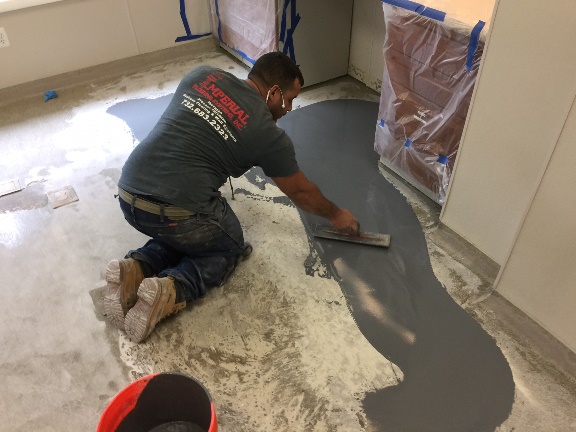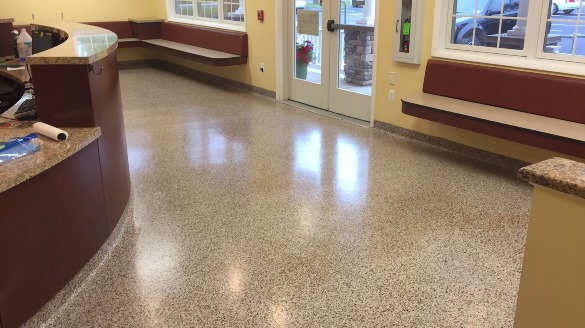Second chances don’t come around very often, so when they do it’s important to make them count. That’s the mentality that Evan Tarabocchia and his crew at Imperial Flooring Systems, Inc. took with a recent renovation at a veterinary hospital in New Jersey.
“Unfortunately the original sub-contractor responsible for the epoxy flooring installation did a horrible job, which almost turned the client away from ever doing epoxy flooring,” said Tarabocchia, president and project manager for the coatings firm. Not only was the two-year-old floor already showing osmotic blistering in areas, such as the operating room, but the coving was inconsistent, areas were sealed improperly or not at all, and dirt seemed to be a permanent fixture. “Through daily use and typical maintenance procedures, the unsealed floor and base would immediately track dirt and stains,” he explained.
Good thing the Imperial Flooring crew was on the case to treat the symptoms.
When the Client’s Happy…
After the four- to five-person crew came in and completed the rehab, the owner developed a different outlook on epoxy floors. “She learned to appreciate it more and obviously has a finish that’s going to last her a lot longer than what she had,” Tarabocchia explained.
So how’d they change her mind?
Giving the client, the owner of Bay Shore Veterinary Hospital, floor samples at the start seemed key to her happiness in the end. The crew started with 10 different colors, and the client narrowed those down to the three she liked best. From there, Imperial Flooring made another three samples, so that the owner could look at the colors and textures together. “Through a long and specific sample process, the color of the floor matched well with the surrounding finishes. The end result was a smooth surface, properly sealed, and easy to maintain,” Tarabocchia said.
The walls throughout the building’s rooms — operating, prep, and waiting rooms; entrance; bathroom; and hallways — were various colors, including tan and brown. Finding a floor system to match could have been tricky, but the multi-colored flake matched throughout. “It was a nice color choice,” said Tarabocchia.
With the system specifics chosen, it was time to start their race. They had the four-day Memorial Day weekend to get everything done, and many items on their checklist!
And They’re Off!
The client closed the building for the entire holiday weekend since it was already a slow period for the company. But that didn’t mean that the Imperial Flooring crew could slack off. In fact, they only had until Monday to finish the floor. Losing no time, they started right in on Thursday night prepping the space.
Although the project covered a total of 3,300 square feet (306.6 m²), that surface was broken up into smaller rooms throughout the building. That meant lots of edges and different kinds of prep. To start, the crew and some of the client’s employees protected all surgical equipment, computers, and supplies with plastic. For the crew, it was then on to grinding.
Wearing dust masks, gloves, knee pads, and ear plugs, the crew prepped open areas with a two-disc 5 HP Terrco Grinder and 24-inch (61.0 cm) grit metal diamonds. “Using this machine in conjunction with the diamonds not only helped ensure a bond but gave us the ability to flatten high spots in the original construction of the concrete slab,” Tarabocchia explained. In areas where the original epoxy was bonded well — about 80 percent in his estimation — the crew aimed to achieve a Concrete Surface Profile (CSP) of 2. “Through diamond grinding, a CSP #2 was achieved, which was sufficient to ensure a bond between the new epoxy flooring system and the existing substrate. Diamond grinding with a Terrco 5 HP machine also assisted with creating a flatter floor,” he continued.

Any areas where the crew ran into blistering, they worked to remove the entire system. “Most of the floor is bonded well, but in certain areas bubbles come up from the floor and that’s where…the blister of water penetrated the coating and therefore it would cause this bubble in the floor,” Tarabocchia said.
The concrete in those areas was replaced with Dur-A-Flex’s Poly-Crete SL. That urethane-based moisture barrier was trowel applied to a thickness of 1/8 to 1/4 inch (0.3‒0.6 cm).
Edges and borders were ground with a Metabo 7-inch (17.8 cm) angle grinder with 30- to 40-grit 7-inch (17.8 cm) diamond cup wheels, and all cant coves were ground with small hand tools and 4-inch (10.2 cm) Makita angle grinders with 4-inch (10.2 cm) diamond blades.
It’s no surprise that the crew worked longer hours during the prep stage of this job. “That initial preparation was a pretty long day, obviously, to get the entire floor prepped and to meet the schedule,” Tarabocchia said. They ran 10 to 12 hours at the start and closer to 8-hour days toward the end.
Coating Crew Unleashed
Areas that weren’t sound or were hollow and removed required patching. The crew used a mixture of 100-percent solids epoxy, silica sand, and Cabot’s Cab-O-Sil thickening agent. A similar blend, this time with Dur-A-Glaze Cove Rez and silica sand, was used to match the remaining radius cove.
Patching and creating the uniform cove throughout the building finished out the crew’s work on Friday, and by Saturday morning, everything was cured. One final grinding plus vacuuming and the crew was finally ready to coat the floors!
In total, the new epoxy flooring finished at an average of 1/16 inch (0.2 cm). The first layer of the system, Dur-A-Gard 50-50, used 1 ounce (28.4 g) of Bond Promoter per gallon (3.8 L) of the coating to ensure adhesion. Wearing gloves and dust masks when necessary, the crew applied that layer using a flat squeegee. They then back rolled the coating with a 3/8-inch (1 cm) nap roller sleeve. Into the wet layer, the crew broadcast the brown, white, and beige vinyl flake by Torginol. The 1/4-inch (0.6 cm) flake was broadcast to rejection.
When the crew returned the next day, Sunday, they vacuumed up any excess flake, scraped off any peaks, and vacuumed once more. According to Tarabocchia, the client “desired a smooth surface. The smooth surface would assist with maintenance and be user friendly for paws of dogs, cats, and other animals.”
Using a squeegee and roller again, the crew applied the first seal coat to the epoxy: a mixture of Dur-A-Glaze Resin and Dur-A-Glaze Water Clear Hardener. “The combination of these two materials helped achieve a bit more working time,” Tarabocchia explained. “We applied this product thicker than normal to achieve a smooth glass-like appearance.” Again, the crew left that layer to cure overnight.
Upon returning, the crew used 40-grit sandpaper to ensure that no peaks still poked through the initial seal coat. They cleaned and vacuumed the debris, and then hit the floor with the final coating, called Accelera, in a satin finish.
“With the amount of windows in and around the building, the satin finished helped avoid light reflection,” Tarabocchia explained. Further, “Accelera was chosen because of its return to service capabilities. Other urethanes, either solvent- or water-based, require a 48-hour cure, but Accelera was cured and dry enough to walk on within a 2- to 3-hour period.”
Dog Days
The crew had a few last-minute tasks, such as removing the protective plastic from the equipment, but they came back at 5 a.m. on Tuesday and left a “nice, clean environment,” according to Tarabocchia. By 8 a.m., the client was able to have consultations and surgeries that very day.
In the end, the Imperial Flooring crew left not only giving the client brand new floors that should last for 10 to 15 years (with proper maintenance), but they also left her with an improved impression on epoxy systems.
“It was a very successful project to say the least,” Tarabocchia said. “Obviously she was happy. It worked out pretty nice for everybody.” Hard work and determination paid off for this dogged crew.
Editor's note: Interested in seeing more pictures of the floor installation project? Watch this video.
